Erica Jurus's Blog, page 7
August 13, 2024
Gather ye rose-buds
 Blush-pink rose at Niagara Falls Botanic Garden – by E. Jurus, all rights reserved
Blush-pink rose at Niagara Falls Botanic Garden – by E. Jurus, all rights reservedRoses are beautiful.
But like all things with great beauty, over the millennia they’ve incited great passions. If you think of them only as an expensive flower to give at Valentine’s, or send in sympathy, or fuss around with in your garden, you’re in for quite a surprise.
I can’t grow them, as I wasn’t blessed with a green thumb, but I do love to visit them, breathe in their fragrances, and take lots and lots of photos.
According to ancient mythology, we have the randy ancient Greek pantheon of gods to thank for the rose – the first flower ever, created from the virgin blood of beautiful Psyche (the goddess of the Soul) after she was seduced by Eros, the god of Love.
However, fossil records show the genus rosa as dating back some 30 million years, found in Europe, Asia, and North America.
Ornamental roses have been cultivated going back to at least 500 BC in China, Persia and other Mediterranean countries. Confucius (551-479 BC) described them being grown in the imperial gardens of the Chou dynasty. They captivated whoever came across them.
 Stunning Hot Cocoa rose at Niagara Falls Botanic Garden – by E. Jurus, all rights reserved
Stunning Hot Cocoa rose at Niagara Falls Botanic Garden – by E. Jurus, all rights reservedThe Romans, in particular, seem to have developed something of an obsession with them. Petals were eaten in gourmet dishes and used to flavour wine, as well as to scent bathwater, carpet floors and scatter as confetti at lavish parties. Emperor Nero reportedly spent four million sesterces (an estimated $10 million in today’s currency) on their velvety-soft petals for a single banquet. There was an extravagant rose festival held annually in Rome called the Rosalia.
Roses were precious indeed. In a mix of religious tradition, it was believed that Cupid (the Roman version of Eros) gave a rose to Harpocrates, an Egyptian god who symbolized silence to both the Greeks and Romans, in exchange for keeping quiet about the love affairs of Cupid’s mother, Venus. (As much as I love roses, if I were Harpocrates, I might have held out for more.)
From this, it became the custom of the Romans to hang a rose from the ceiling of a meeting to indicate that the contents were to be kept private/a secret. This led to the phrase “sub rosa” (literally ‘under the rose’), which is still used today with the same intent.
Rose garlands were placed on Roman tombs to honour the spirits of the dead, a custom that continues today in floral bereavement arrangements.
From the old, simply-flowered wild roses, today there are over three hundred species of rose. Different species of rose hybridize easily, leading to the development of the enormous range of cultivated garden roses. It’s estimated that there are now something like 30 to 35 thousand hybrids and cultivars.
Roses range in size from compact, miniature roses to climbers that can reach seven meters in height. They generally have “prickles” – not thorns (according to rose experts). Thorns are modified stems, whereas prickles are outgrowths of the epidermis (the outer layer of tissue of the entire plant, meaning that prickles can be found in places other than the stem – let’s make sure we get this right  ). Rose prickles are typically sickle-shaped hooks, which help roses hang on to other vegetation, or fences, making some of them excellent climbers. Despite these defensive prickles, deer seem to be able to get around them and like nosh on roses, requiring protective fencing in some areas (the Niagara Falls Botanic Garden is surrounded by a substantial fence with latching gates, although now a beautifully ornamental fence is being built).
). Rose prickles are typically sickle-shaped hooks, which help roses hang on to other vegetation, or fences, making some of them excellent climbers. Despite these defensive prickles, deer seem to be able to get around them and like nosh on roses, requiring protective fencing in some areas (the Niagara Falls Botanic Garden is surrounded by a substantial fence with latching gates, although now a beautifully ornamental fence is being built).
There are three main types of roses: Wild Roses, Old Garden Roses and Modern Roses. Most the roses in gardens today are considered Modern Roses, which were bred for large blooms continuously throughout the growing season.
Wild Roses, or “species roses,” typically have a single bloom with a five-petalled flower. They’re almost always pink; it’s unusual to find any red or white ones, and a yellow Wild Rose is extremely rare.
 Wild rose – by E. Jurus, all rights reserved
Wild rose – by E. Jurus, all rights reservedOld Garden Roses are often called “antique” roses and “historic” roses, They have double blooms with a strong fragrance, but they only bloom once per season. However, they’re very hardy and disease-resistant.
Modern Garden Roses began being bred after 1867, taking the place of heritage Old Garden Roses. They provide a continuous, larger bloom and last longer as cut flowers in vases, but typically have little fragrance and are less hardy and disease-resistant than their predecessors. Well, as the saying goes, you can’t have everything.
Hybrid Tea, Grandiflora and Floribunda roses are specific varieties.
When hybridizers in the 1800s crossed the ancient China rose, Rosa chinensis, with the European Rosa gigantea, the resulting flower had a smell that was said to be reminiscent of a cup of China tea and so it was nicknamed the ‘tea rose’. Hybrid teas have numerous ornate blooms with 30 to 50 petals on long stems and are dazzling in gardens. Thousands of varieties have been bred, and outdated hybrids make way for the new constantly.
 Valencia Hybrid Tea Rose at Niagara Falls Botanic Garden – by E. Jurus, all rights reserved
Valencia Hybrid Tea Rose at Niagara Falls Botanic Garden – by E. Jurus, all rights reservedShrub roses are notable for their cold hardiness. Their blooms are produced in bountiful clusters on sprawling shrubs anywhere between five and 15 feet in every direction. Shrub roses have several subcategories, one of which is the David Austin English Rose.
There are far too many other varieties of roses to even mention. Let’s look at their uses over the centuries, from scents and flavouring to religious and political propaganda.
Rose perfumes are made from rose oil (also called attar of roses), which is obtained by steam-distilling the crushed petals of roses. The weight of oil extracted is miniscule – about 1/3000th to 1/6000th of the weight of the flowers themselves. Around two thousand flowers are required to produce a single gram of oil – hence the costliness and value dating back to ancient times. (Perhaps Harpocrates was smarter than I gave him credit for.)
The flower stems and young shoots of roses are edible, as are the petals (without the white or green bases). Rose water, made by steeping the petals in water, is used to flavour food and scent cosmetics, as well as for medicine and religious practices. The technique originated in Persia and then spread through Arabia and India; I’ve bought bottles of food-grade rosewater in shops carrying ‘exotic’ foods to flavour my baking with. It’s a lovely flavouring, but must be used in moderation, or your food can begin to taste ‘soapy’. Candied rose petals look beautiful as a garnish on romantic desserts.
Rose hips, the fruit of the plant, are high in vitamin C, and can be made into jams, jellies and marmalades. You may have imbibed rose-hip tea to ward off a cold.
Rose petals can be used to flavour black tea, which easily picks up the essences of things around it (this is one of the reasons you store it in sealed containers, and preferably not around any other foods).
 Screenshot Murchie’s website, with four rose-flavoured tea offerings
Screenshot Murchie’s website, with four rose-flavoured tea offeringsRoses have been adopted as symbols of both good and bad for millennia.
In ancient Greece, the rose was closely associated with the goddess of love, Aphrodite. In Homer’s epic Iliad, she protected the body of Hector using the “immortal oil of the rose”, and nursed a beautiful young man “among rose blossoms”. She created red roses by wounding herself on a thorn – nay, “prickle” – and staining the flower with her blood.
The rose became identified with the Virgin Mary when the Roman Empire was Christianized. The rose symbol eventually led to the creation of the “rosary” and other devotional prayers in Christianity.
Since the 1400s, the Franciscan order has had a Crown Rosary of the Seven Joys of the Blessed Virgin Mary (The Annunciation, Nativity of Jesus, Adoration of the Magi, Resurrection of Christ, Ascension of Christ to Heaven, Pentecost, and finally Coronation of the Virgin in Heaven). In the same time period, the Carthusians promoted the idea of sacred mysteries associated with the rose symbol and rose gardens.
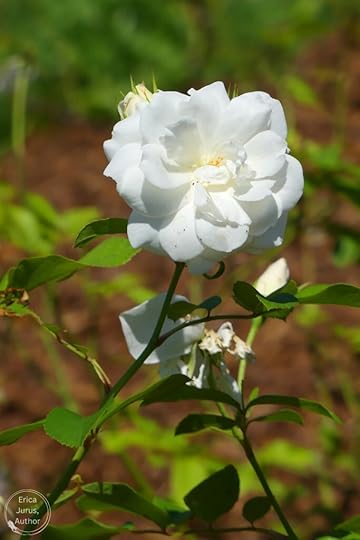 Iceberg floribunda rose in Niagara Falls Botanic Garden – by E. Jurus, all rights reserved
Iceberg floribunda rose in Niagara Falls Botanic Garden – by E. Jurus, all rights reservedChristianity was initially opposed to the use of the rose as a symbol for the Virgin Mary because of the flower’s association with ancient Roman ‘debauchery’. Ultimately, though, the rose was declared “the most perfect of flowers,” and was believed to have grown without prickles when it grew in Paradise, until the Original Sin of Adam and Eve.
Consequently, Mary came to be represented by a white and thornless (prickle-less) rose, and even appeared as a symbol of chastity in paintings, such as Nicholas Hilliard’s famous ‘Pelican’ portrait of Elizabeth I.
The story of Aphrodite cutting herself on the prickles of a rose bush to help her dying lover, Adonis, led to the rose being associated with blood and death, and the rose then became a symbol for Christ: his crown of thorns were those of a rose bush.
In literature, the rose took on a certain concupiscence. A 13th century tale, Le Roman de la Rose (The Romance of the Rose), was full of puns about seizing young buds, rosy de-flowerings, pricking, scattering seed and the like. The term ‘deflower’, came from the 17th-Century English botanist Nicholas Culpeper, who compared the female genitalia to a half-blown rose. By Victorian England, roses were, unsurprisingly, considered offensively sexual.
Shakespeare made great use of roses in his plays, most famously in Romeo and Juliet, which has one of the most famous quotes ever made about the flower: “What’s in a name? That which we call a rose,
By any other name would smell as sweet.”
 Poseidon floribunda rose – by E. Jurus, all rights reserved
Poseidon floribunda rose – by E. Jurus, all rights reservedIn Charles Dickens’ A Tale of Two Cities, the rose resume its political connotation during the French Revolution when Madame Defarge added roses to her hat to signify the presence of possible spies or supporters of the French monarchy to other revolutionaries.
The classic fairy tale Beauty and the Beast, hinged upon a rose wrongly snipped. Belle’s loving father plucked a beautiful rose to bring home to his daughter, because it’s the only treat she requested, but it was from the cursed Beast’s garden, and as payment she was forced to live as a prisoner of the very garden where it had grown.
My favourite literary mention, though, is in Alice in Wonderland, where the nasty Queen of Hearts made her gardeners, who’d accidentally planted white roses, laboriously paint them all red. If not, their own heads would be clipped.
Politically, roses have become popular symbols. In 15th-Century England, the rival “houses” of Lancaster (Red Rose) and York (White Rose) carried out the now-famous Wars of the Roses for control of the throne. When the first Tudor monarch, Henry VII, defeated Richard III and married Elizabeth of York, he created the Tudor Rose out of both colours. The Tudor Rose eventually became a national symbol of England.
 The Tudor Rose – By Sodacan – Own work, CC BY-SA 3.0, https://commons.wikimedia.org/w/index.php?curid=12740207
The Tudor Rose – By Sodacan – Own work, CC BY-SA 3.0, https://commons.wikimedia.org/w/index.php?curid=12740207More recently, in 1986 President Ronald Reagan signed legislation to make the rose the floral emblem of the United States.
Roses have made their way into many arenas. The well-known Compass Rose, a stylized visual device on maps to point out East, South, West and North, was actually derived from what’s known as a Wind Compass, an even earlier graphic from the 1300s on portolan charts (nautical charts with entries such as currents, bays and ports). Wind roses showed the frequency of winds blowing from particular directions over a specified period of time. They used 16 cardinal directions, such as north (N), NNE, NE, etc., , and are still used today in constructing airport runways, since the wind can affect the speed of aircraft at both landing and takeoff when pointing against it.
 Stylized compass rose on the floor of the Titanic Museum in Belfast, Northern Ireland – by E. Jurus, all rights reserved
Stylized compass rose on the floor of the Titanic Museum in Belfast, Northern Ireland – by E. Jurus, all rights reservedRoses of course made their way into fashion. There was even a famous colour in Victorian England called Ashes of Roses, a somewhat greyish-rose colour that seems appropriate for such a repressed society. It stuck around in Edwardian times, but was renamed Old Rose (less cumbersome, apparently, and perhaps viewed as a little old-fashioned by then.

As you can see, the originally humble rose grew into great prominence and significance since it first appeared on our Earth. Today it still graces the pages of novels and delights both gardeners and garden visitors, and I for one am very happy that it has transcended all the turmoil and survived as an item of remarkable beauty and elegance.
As poet Robert Herrick wrote:
Gather ye rose-buds while ye may,
Old Time is still a-flying:
And this same flower that smiles to-day,
To-morrow will be dying.
 Perfect deep pink rose bud – by E. Jurus, all rights reserved.
Perfect deep pink rose bud – by E. Jurus, all rights reserved.In other words, stop and smell the roses!
The post Gather ye rose-buds first appeared on Erica Jurus.
August 6, 2024
The music of summer
 Enjoying lunch and the view in Bemus Pt, a classic lakeside resort town on Chautauqua Lake in NY state – photo by E. Jurus, all rights reserved
Enjoying lunch and the view in Bemus Pt, a classic lakeside resort town on Chautauqua Lake in NY state – photo by E. Jurus, all rights reserved
Sweet Rosie O’Grady,
My dear little Rose,
She’s my steady lady,
Most ev’ryone knows.
And, when we are married,
How happy we’ll be;
I love sweet Rosie O’Grady,
And Rosie O’Grady loves me.
Fairgrounds have always been as much about the sights and sounds as the attractions – the clacking of rides, shouting of barkers, children’s (and adults’) screams and laughter, and the music drawing rider onto the carousel.
The lyrics above are from a popular fairground piece of music written by Maude Nugent, an American singer and composer. She composed and wrote the lyrics to “Sweet Rosie O’Grady” in 1896 and sold the song to Tin Pan Alley publisher Joseph W. Stern & Co. (Tin Pan Alley was a well-known group of songwriters and music publishers in New York City in the late 19th and early 20th centuries.) It became one of the most popular waltz standards of the time, its sheet music selling over a million copies. In 1949 she even performed it on The Ed Sullivan Show.
Nugent wasn’t the only composer by far whose music made onto player pianos and carousel organs, as well as the travelling military band organs – Scott Joplin, Thomas ‘Fats’ Waller, Gustav Mahler and Liberace were just a few of the many well-known composers who graced the fair grounds.
Fairs, in their purest form as local festivals, have been around since Roman times at least. They evolved into more permanent places of entertainment in Europe as ‘pleasure gardens’, and also world fairs, both of which gave rise to amusement parks, with rides, games of “chance and skill”, thrill acts, and food and merchandise stalls, much as they still are today. Music was added, and as the rides became mechanized and the crowds large, fairground organs were developed that could play quite loudly above all the ambient noise.
These organs were designed to accompany various rides and attractions, but primarily carousels. The organs were designed to replicate the capabilities of a human band – hence their common name in the U.S., band organs.
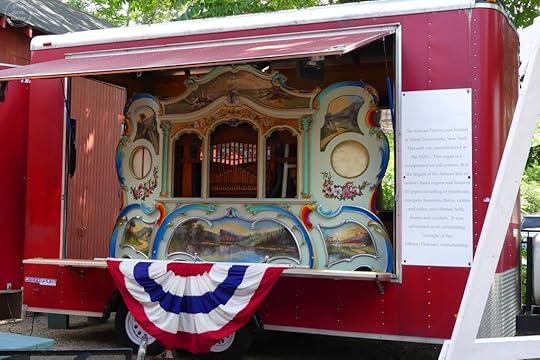 Artizan travelling military band organ at the Herschell Factory Museum in N. Tonawanda, NY – photo by E. Jurus, all rights reserved
Artizan travelling military band organ at the Herschell Factory Museum in N. Tonawanda, NY – photo by E. Jurus, all rights reservedEarly organs were played by a similar system to music boxes: a rotating barrel with the sounds triggered by metal pins.Later organs used punched strips of cards called ‘book music’. These then developed into music rolls – rolls of perforated paper with the music encoded into markings that the automatic reader system could recognize.

Watching these old organs pour out a remarkable amount of sound is fascinating. They use a series of pipes that sit on top of a hollow wind chest. The wind chest shoves air into a pipe, which causes the air to oscillate and produce a sound. Groups of pipes, called ‘ranks’, contain knobs that activate a slider under specific sets of pipes. These are known as ‘stops’ – they allow air to flow through the pipes to make a sound. The expression “pulling out all the stops” comes from doing this on an organ to allow every pipe to make noise.
The air comes from bellows that pump it in compressed form into the wind chest, which itself contains a series of valves (pallets) connected to either a keyboard (in a regular organ) or to the device which reads the punches on a music roll in player pianos and organs. On band organs, a wheel at the back of the organ turns a crankshaft that operates the pump stick driving the bellows. Many people call a band organ’s music “the happiest music on earth.”
The three different types of band organs – those operating on a cylinder, called barrel organs, book organs that use folded cardboard books for the music, and those operating on paper music rolls – each produce a different kind of sound.
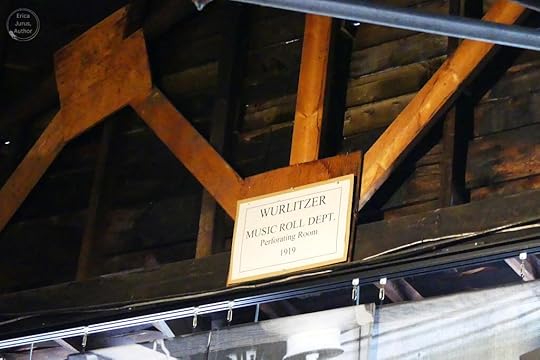
Eugene de Kleist was an early builder of barrel organs for use in carousels in North Tonawanda, New York. Wurlitzer bought an interest in his Barrel Organ Factory in 1897, and a few years later Wurlitzer bought the entire operation, moving all Wurlitzer manufacturing from Ohio to the New York site. From 1914 to 1942, Wurlitzer built over 2,243 pipe organs in the new factory.
They also built jukeboxes, which became the iconic jukebox of the Big Band era, and theatre organs. The “Mighty Wurlitzer” theatre organ was introduced in late 1910; it became their most famous product. Wurlitzer theatre organs were installed around the world in theatres, churches, museums and private homes.
The largest Wurlitzer organ originally built was the 58-rank instrument at Radio City Music Hall in New York City. It’s actually a concert instrument, capable of playing a classical repertoire as well as non-classical music.
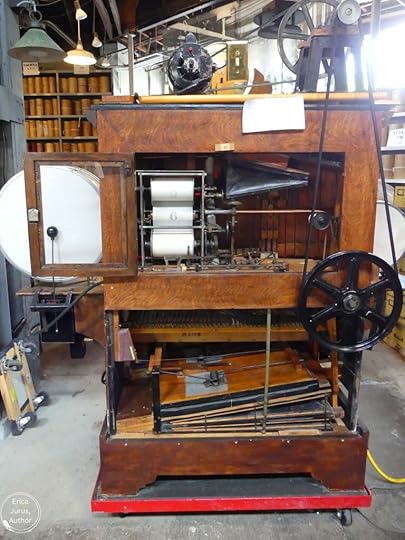
Fairground organs are typically run by wind under pressure, generated from mechanically powered bellows in the instrument’s base. In the photo above, you can see the bellows at the base of the organ, being run by a pulley and belts. These instruments are keyboard-less (except for a few rarer configurations with one or more accordions, whose keys could be seen to move).
With the advent of computer control, some band organs have been built or converted to be played electronically, but I prefer the nostalgia of the original instruments, where you can watch the rolls of music scroll through their holders, and even see the perforations work their magic. On this organ at the Herschell Factory Museum, I watched 4 short perforations in sequence make the little stick on the white snare drum pound out a flurry of beats.
Music books and rolls were essentially early media storage devices. Music rolls were invented by Gavioli & Cie, an organ builder company in Italy and France. The rolls were more compact and cheaper to make than book music. Both books and rolls ran with different operating actions that read the music either with air pressure, suction, or mechanically, using a sensing device called a tracker bar, that would then play the instrument.
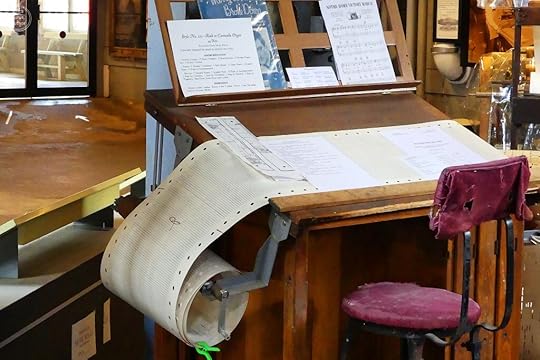 A desk at the Herschell Factory where music pieces were arranged and marked onto rolls of paper, to be transferred by punches to the actual music rolls, as seen below – photo by E. Jurus, all rights reserved
A desk at the Herschell Factory where music pieces were arranged and marked onto rolls of paper, to be transferred by punches to the actual music rolls, as seen below – photo by E. Jurus, all rights reserved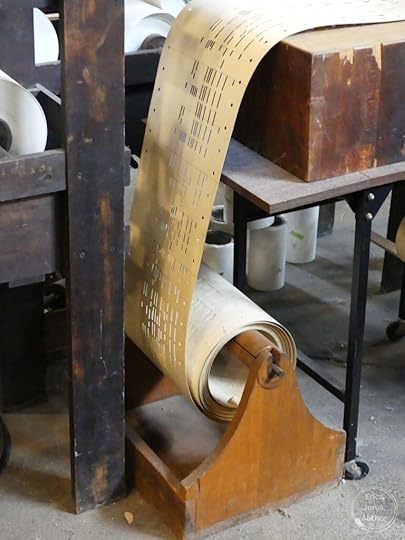
 Punches in different sizes to make the musical notations on the music rolls – photo by E. Jurus, all rights reserved
Punches in different sizes to make the musical notations on the music rolls – photo by E. Jurus, all rights reservedAfter rolls are played, they have to be rewound before they can be played again, like the defunct VHS video tapes that played stored TV shows and movies. To overcome this break in a musical performance, some instruments were built with two player mechanisms (called a ‘duplex roll’), allowing one roll to play while the other rewound. To extend the longevity of the storage pieces, mechanically-read cardboard book music was typically fortified with an application of shellac, while music rolls were made with moisture-resisting paper stocks.
 A sample of music roll, illustrating some of the notations and how thin the paper actually is – photo by E. Jurus, all rights reserved
A sample of music roll, illustrating some of the notations and how thin the paper actually is – photo by E. Jurus, all rights reserved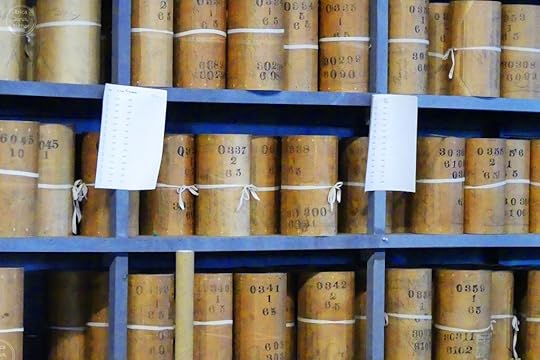 Shelves upon shelves of preserved music rolls, still being used, at the Herschell Factory Museum – photo by E. Jurus, all rights reserved
Shelves upon shelves of preserved music rolls, still being used, at the Herschell Factory Museum – photo by E. Jurus, all rights reservedThe organ workings were typically covered with an ornate decorative façade that was designed to attract attention, as was the case with most fairground equipment – making the equipment its own bright advertisement.
The case facades were often adorned with percussion instruments such as snare drums as well as animated human figures such ‘conductors’ whose arms moved in time to the music, or women striking bells, that provided visual entertainment as they played.
 Magnificent band organ under restoration at the Herschell Factory Museum, showing an elaborate trumpet system as well as the front of one of the snare drums on each side – photo by E. Jurus, all rights reserved
Magnificent band organ under restoration at the Herschell Factory Museum, showing an elaborate trumpet system as well as the front of one of the snare drums on each side – photo by E. Jurus, all rights reservedWurlitzer partnered with George Herschell, James Armitage and other businessmen from the area, and constructed a separate plant in downtown North Tonawanda. It manufactured organs and hurdy-gurdies for amusement parks, carnival midways, circuses and roller rinks, and assembled amusement rides, particularly carousels, right at the factory.
Wurlitzer had early success from defense contracts to provide musical instruments to the U.S. military, which I’m assuming gave rise to some organs – including the one that greets visitors majestically at the Herschell Factory Museum – being labelled as ‘military band organs’. Its theatre organs were popular in movie houses during the days of silent movies. The company also had a chain of retail stores where consumers could buy their products.
The music of carousels and band organs truly is the music of summertime, and happily you can still find it in thriving amusement parks and carousels around the world.
So, there’s a piece of the story behind the Llithfaen carousel in my Chaos Roads Trilogy – but not all of it by a long shot. The strangeness of that carousel begins to emerge in Book 2, Into the Forbidden Fire, that is now available in paperback and ebook on Amazon. The final novel in the trilogy will reveal the final details…
In the meantime, take the opportunity to explore and enjoy these charming remnants of a time gone, but definitely not forgotten, and the modern amenities that round out the pleasure of a leisurely summer day.
 Fish tacos and coleslaw at the Ellicottville Brewing Co. restaurant in Bemus Pt, NY – photo by E. Jurus, all rights reserved
Fish tacos and coleslaw at the Ellicottville Brewing Co. restaurant in Bemus Pt, NY – photo by E. Jurus, all rights reserved A frosty “adult” milkshake at the restaurant, made with Oreo Cookies and Skrewball Peanut Butter Whiskey – photo by E. Jurus, all rights reserved
A frosty “adult” milkshake at the restaurant, made with Oreo Cookies and Skrewball Peanut Butter Whiskey – photo by E. Jurus, all rights reservedThe post The music of summer first appeared on Erica Jurus.
July 30, 2024
The wonderful world of vintage carousels – Part 1
 The beautiful Canopy and Rounding Boards of the Lakeside Park Carousel – photo by Erica Jurus, all rights reserved
The beautiful Canopy and Rounding Boards of the Lakeside Park Carousel – photo by Erica Jurus, all rights reservedMusic. Hot dogs and ice cream. Sunshine and breezes. Rides.
Memories of childhood summers in the 1900s, and not just in that century. Happily, old-fashioned amusement parks still exist, and families still turn out to enjoy their simpler pleasures, free from timed attractions, long lineups and exorbitant prices.
Summertime when I was growing up: going on all the rides at Lakeside Park in Port Dalhousie. The “Playground of Ontario”, as the park was once known, sits on a wide beach fronting the deep blue waters of Lake Ontario. There’s a lighthouse at the end of a long pier that’s been a fixture of the park for as far back as I can remember, as is the carousel.
It’s the only remaining ride even from the days of my youth, when there were a number of rides including a tower with swinging airplanes (one of my favourites). I wish I’d had the foresight to take photos back then.
In the park’s heyday, though, there were numerous attractions.
The area of the park was located at the entrance of the first Welland Canal, back in 1829, and housed a variety of taverns where the sailors and canal workers would hang out on their down time. When a streetcar service was created linking Port Dalhousie to Niagara Falls in the 1880s (the importance of this will be made clear shortly), along with a passenger steamship across the lake and back from Toronto, the tourist traffic began.
The Niagara, St. Catharines, and Toronto Navigation Company (NS&T), owned by the Railway of the same name, leased the beach and ran tracks from an existing pier across the beach in 1901 to increase business to an area growing in popularity.
With a perfect beach for swimming, food concessions began to pop up, along with amusement rides, from bumper cars, row boats, miniature golf, a water slide, and the carousel, along with a bathing pavilion, a bandstand and dance pavilion, picnic spots and a baseball diamond. There was a variety of live entertainment – bands and orchestras, magicians and other stage shows, and tournaments on the ball field. The Lakeside Inn Restaurant at the ferry pier offered fine dining (85 cents for a full-course meal).
All that remains of those halcyon days is the beach (still well-used), the picturesque lighthouse, the carousel (still running for 5 cents a ride) and a pavilion named for Neil Peart, the drummer for Rush, who worked at Lakeside Park in the 1960s as a carnival barker. In his 2004 book, Traveling Music: Playing Back the Soundtrack to My Life, Neil wrote, “some of the kids brought transistor radios to work, and the music of that summer of 1966 played up and down the midway. At night, when the midway closed, we gathered around a fire on the beach, singing. Lakeside Park resonated in my life in so many deep ways, especially those fundamental exposures to music that would be forever important. It’s all gone now. All that’s left, apart from memories, is the old merry-go-round.”
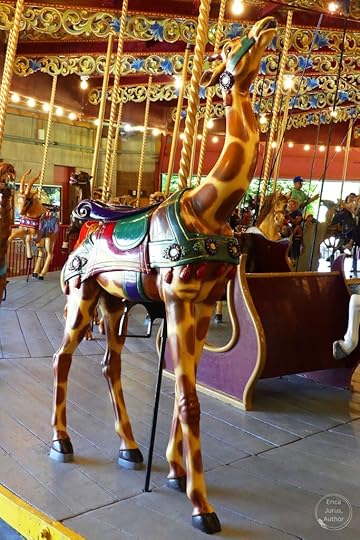 Detailed stationary giraffe at Lakeside Park – photo by Erica Jurus, all rights reserved
Detailed stationary giraffe at Lakeside Park – photo by Erica Jurus, all rights reservedThere’s something about carousels, a kind of mystique behind the elaborate animals that carry riders around, whether stationary (“standers”) or moving hypnotically up and down (“jumpers”).
The Lakeside Carousel was built by Charles I. D. Looff, a master carver and builder based in Riverside, Rhode Island, is credited with making about forty carousels between 1876 and 1916, Only about ten of his forty carousels still survive. They’re known for their lavish decorations, sparkling mirrors and jewels. The lion is an original Looff lion, one of only five existing Looff lions in North America. It’s the only one that has its head turned to watch onlookers as it passes by them.
 The magnificent Looff lion in Port Dalhousie – photo by Erica Jurus, all rights reserved.
The magnificent Looff lion in Port Dalhousie – photo by Erica Jurus, all rights reserved.Old-fashioned amusement parks, where carousels are a starring attraction, are a dying breed. Luckily we recently found one in Bemus Point, NY, and spent a wonderful (if a bit rainy) couple of days exploring it and the surrounding summer resort area.
 Entrance sign – photo by Erica Jurus, all rights reserved
Entrance sign – photo by Erica Jurus, all rights reservedMidway State Park is small, and a far cry from places like Disneyworld, but it’s a delightful slice of history that many people still enjoy, a microcosm of simpler times. I know that’s a terrible cliché, but these days I feel like we could all use such an escape.
Along with being one of the oldest amusement parks in the U.S., Midway is a “Trolley Park” and one of only eleven remaining. At one time, every major American city had at least one of them.
Trolley Parks were the forerunners of amusement parks. They were developed in the 19th century and were located along or at the terminus of streetcar lines as a way to get more customers by providing direct transportation. These parks began with pavilions and picnic areas, which Midway still has, and often held concerts and dances, along with fireworks displays. Eventually more features were added, including carousels, Ferris wheels, and other now-traditional amusement park rides. I think it would be fair to refer to Lakeside Park as a Trolley Park.
 Midway Carousel – photo by Erica Jurus, all rights reserved
Midway Carousel – photo by Erica Jurus, all rights reserved Tilt-A-Whirl ride at Midway State Park – photo by Erica Jurus, all rights reserved
Tilt-A-Whirl ride at Midway State Park – photo by Erica Jurus, all rights reserved Original early 1900s concessions building at Midway State Park- photo by Erica Jurus, all rights reserved
Original early 1900s concessions building at Midway State Park- photo by Erica Jurus, all rights reserved Fabulous fish tacos at the Ellicottville Brewing Co. restaurant in Bemus Point NY – photo by Erica Jurus, all rights reserved
Fabulous fish tacos at the Ellicottville Brewing Co. restaurant in Bemus Point NY – photo by Erica Jurus, all rights reserved An ‘adult’ version of ice cream: the Chocolate-Peanut Butter Milkshake, with liquor, at Original early 1900s concessions building at Midway State Park- photo by Erica Jurus, all rights reserved
An ‘adult’ version of ice cream: the Chocolate-Peanut Butter Milkshake, with liquor, at Original early 1900s concessions building at Midway State Park- photo by Erica Jurus, all rights reservedWe enjoyed our visit to Midway and the area around Chautauqua Lake. After we got home, I was curious to find out more about the park’s carousel, and discovered that it was built by the Herschell Company in North Tonawanda, NY – only an hour away from where we live. The factory is now a museum, and of course we had to make a pilgrimage to check it out!
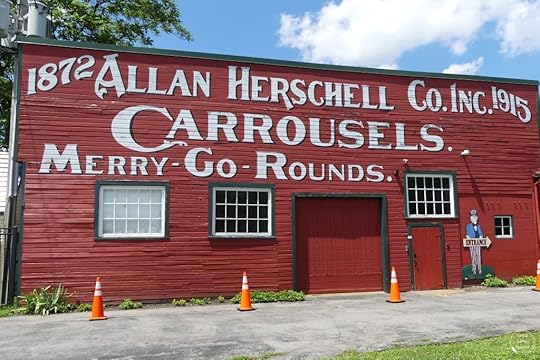 photo by Erica Jurus, all rights reserved
photo by Erica Jurus, all rights reservedWhat a blast from the past! When you arrive, you’re greeted by a vintage military band organ that still has a powerful voice.
 The Artizan military band organ at the Herschell Museum – photo by Erica Jurus, all rights reserved
The Artizan military band organ at the Herschell Museum – photo by Erica Jurus, all rights reservedThis organ still runs with pipes to make the sounds, a bellows to pump air through them, and perforated sheet music to play the classic tunes. You can poke around the back of the beast, and an operator there will happily explain all the workings.
 photo by Erica Jurus, all rights reserved
photo by Erica Jurus, all rights reservedInside the museum, you’re surrounded by colourful artifacts from a bygone age – vintage carousel animals…
 Vintage carousel animals in the museum, including an unusual ostrich – photo by Erica Jurus, all rights reserved
Vintage carousel animals in the museum, including an unusual ostrich – photo by Erica Jurus, all rights reserved… vintage cars from various early amusement parks, including cars from the Little Dipper rollercoaster in Crystal Beach, Fort Erie – a massively popular amusement park in the 1900s …

 Vintage carousel animals in the museum, including an unusual ostrich – photo by Erica Jurus, all rights reserved
Vintage carousel animals in the museum, including an unusual ostrich – photo by Erica Jurus, all rights reserved… and a beautiful carousel inside that you can have a ride on for the price of a cardboard chip (included with admission).
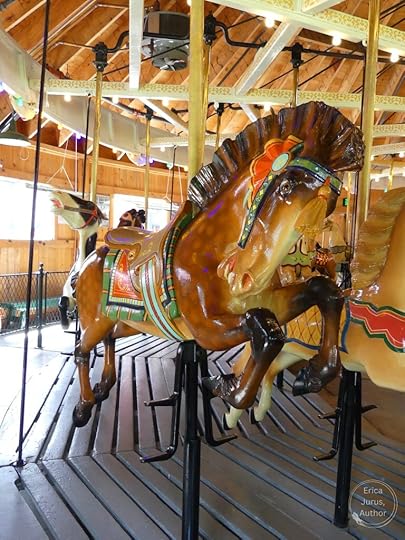 Detail of Herschell Carousel in N Tonawanda, NY – photo by Erica Jurus, all rights reserved
Detail of Herschell Carousel in N Tonawanda, NY – photo by Erica Jurus, all rights reservedThere are vintage signs showing how tall you have to be to ride by yourself.
 photo by Erica Jurus, all rights reserved
photo by Erica Jurus, all rights reservedCarousel animals are an art form, carefully being preserved at the Factory Museum. While modern animals are cast with molds, all the original animals that we’ve all ridden on and loved were meticulously carved by hand.
The process, vividly displayed inside the old factory, began with a detailed drawing, because the animals weren’t made by a single artist, but by several, and everyone had to be on the same page.
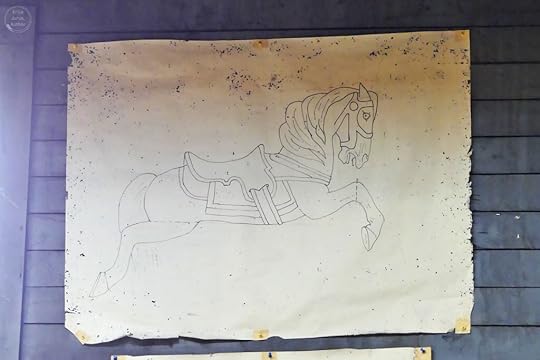 Pre-production diagram of a carousel horse at the Herschell Museum factory – photo by Erica Jurus, all rights reserved
Pre-production diagram of a carousel horse at the Herschell Museum factory – photo by Erica Jurus, all rights reservedThick pieces of wood, usually poplar (for its light weight and ease of carving), were laminated together in sections – the head, the torso and the legs.
The beasties had a small hollow section in the torso, to reduce weight and materials. An average carousel horse weighed only about 80 pounds.
 The carousel animal ‘production line’ at the Herschell factory – photo by Erica Jurus, all rights reserved.
The carousel animal ‘production line’ at the Herschell factory – photo by Erica Jurus, all rights reserved.You’ve probably never noticed (I certainly hadn’t) but carousel animals are only completely carved and finished on the side that faces outward, dazzling viewers waiting to get on the ride. The opposite side is still carved, but not as elaborate.
 The same horse, but on its outward-facing side, considerably more ornate and detailed – photo by Erica Jurus, all rights reserved.
The same horse, but on its outward-facing side, considerably more ornate and detailed – photo by Erica Jurus, all rights reserved.Carvers all had different styles.
Marcus Charles Illions, who carved some of the creatures in the carousel at Lakeside Park, had his own stables so that he could study the motions of his horses. He originated what’s called the ‘Coney Island style’, very flamboyant, with lots of gold and silver decoration. He also usually signed his carvings, as opposed to most carvers. The Lakeside carousel horses still have real horsehair tails. Illions was called “the Michelangelo of carousel carvers” by the New York Times newspaper.
Charles W. F. Dare was originally a manufacturer of children’s toys, including rocking horses. In 1867, his retail/manufacturing business was listed as selling/manufacturing hobby horses, but around that time he transitioned to making carousels. He employed a carver, Andrew Christian, and his company became known for their simplistic horses and figures – often described as primitive and “toy-like”, akin to his earlier work. Nevertheless, all of Dare’s horses had real horsehair tails and manes, along with ears and saddles of leather. His carousels were plain but sturdy, and easy to both transport and store – ideal for travelling fairs and carnivals. One of his features was his “flying horses”, mounted on chains so that as the carousel turned, centrifugal force would allow the horses to “fly” outward.
Some carvers worked for a single company while others moved from shop to shop or supplied figures to more than one company. Many carvers were also manufacturers who made the complete machine, but others, like Marcus Illions, teamed up with another company that made the structured parts of the carousel animals (frames, platforms, machinery).
Records about carvers, who were such skilled masters, are unfortunately sparse because most didn’t sign their animals. At the Herschell factory, although it seems that Allan Herschell himself was never a carver, there were no names of any carvers noted.
Herschell was the largest manufacturer of carousels in the United States. The factory produced over 3000 of them, shipping them throughout North America as well as around the world, including to South Africa, India and Tahiti.
Allan Herschell, had emigrated with his family in 1870 from Scotland to Buffalo, New York. Allan found work in factories, but, an industrious fellow  , at the age of twenty, partnered with James Armitage to create their own business, the Tonawanda Engine and Machine Company in North Tonawanda. However, he was diagnosed with lung disease not long after, and his physician recommended that he move on from manufacturing boilers. A visit to New York City introduced him to carousels (probably one made by Dare), and he built his first one not long after, powered by one of his own steam engines. Within seven years, his factory was producing a carousel every day.
, at the age of twenty, partnered with James Armitage to create their own business, the Tonawanda Engine and Machine Company in North Tonawanda. However, he was diagnosed with lung disease not long after, and his physician recommended that he move on from manufacturing boilers. A visit to New York City introduced him to carousels (probably one made by Dare), and he built his first one not long after, powered by one of his own steam engines. Within seven years, his factory was producing a carousel every day.
In 1903 he bought out the Armitage-Herschell Company and partnered with his brother-in-law, Edward Spillman, forming the Herschell-Spillman Company, the largest manufacturer of carousels in the United States. Their steam-powered carousels were small, with intricately-designed horses, menagerie animals and even storybook characters.
Herschell had to retire a few years later because of ill health, but by 1914, with the help of a carving machine, the Herschell-Spillman company was making large, permanent, park model carousels. Marcus Illions even supplied the horses for one of them.
In 1915, Herschell re-entered the carousel business on his own and founded the Allan Herschell Company in direct competition with the Herschell-Spillman Company. He returned to producing the easily dismantled and packed carousels for traveling carnivals. The first carousel made by his reinvented company, the No. 1 Special, completed in 1916, is still at its original site at the factory my hubby and I visited, and rode, in North Tonawanda, NY.
A number of years ago we’d seen another beautiful carousel at Greenfield Village, part of the Henry Ford Museum in Dearborn, Michigan, and I combed through the photos to include some of that carousel. To my amazement, the artwork on the Greenfield carousel clearly identified it as a Herschell-Spillman creation. Synchronicity hard at work!
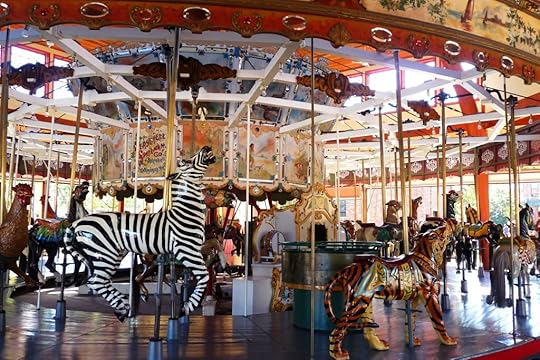 The Herschell-Spillman Carousel in Greenfield Village – photo by Erica Jurus, all rights reserved.
The Herschell-Spillman Carousel in Greenfield Village – photo by Erica Jurus, all rights reserved.That carousel was made in 1913, while Allan Herschell was still part of the company. The craftsmen created the widest variety of hand-carved carousel animals of any manufacturer – zebras, giraffes, storks, sea creatures, and even giant green frogs, produced only by Herschell-Spillman. We saw two of them on the shop floor in North Tonawanda (the photo in last week’s post), and they are also the only carousel animals that wore human clothes.
In Tonawanda we were given an intimate view into the creation of these wonderful rideable animals, as well as the music that’s been an iconic part of carousels since their beginnings. But that’s a story for Part 2, in next week’s blog.
There are about 350 antique hand-carved carousels still operating in North America, including the one at Lakeside Park in Port Dalhousie. Only nine of them are in Canada, which makes Lakeside very special.
I treasure these slices of history and gentler times past. Our visit to the Herschell Carrousel Factory Museum was so much fun; we could easily have spent an entire afternoon just talking with the docent in the factory section. If you’re ever in the area, do go and visit it, and become a child again for a few hours.
180 Thompson Street, North Tonawanda NY, 14120
 Herschell horse with details of glass eyes and jewelled bridle – photo by Erica Jurus, all rights reserved.
Herschell horse with details of glass eyes and jewelled bridle – photo by Erica Jurus, all rights reserved.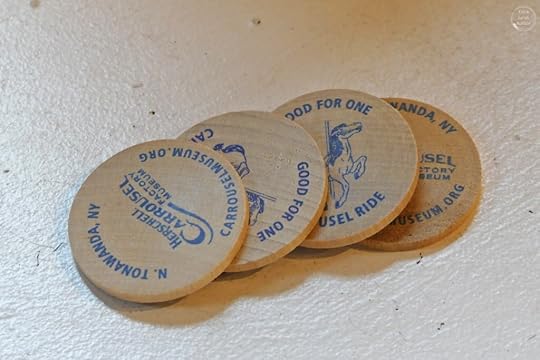 Vintage cardboard tokens to ride the Herschell carousel in N Tonawanda – photo by Erica Jurus, all rights reserved.
Vintage cardboard tokens to ride the Herschell carousel in N Tonawanda – photo by Erica Jurus, all rights reserved.The post The wonderful world of vintage carousels – Part 1 first appeared on Erica Jurus.
July 23, 2024
The wonderful world of vintage carousels — preview
 Carousel frogs in production – photo by E. Jurus, all rights reserved
Carousel frogs in production – photo by E. Jurus, all rights reservedAfter dinner I closeted myself in Alistair’s study. With a bit of hunting, I found the book about carousels on one of the shelves.
It was titled Garosello, the Little Battle of the Animals. There was a photo of a classic prancing horse on the cover. I’d always loved carousels, so I took a few minutes to skim through some of the history the author had provided.
The rotating rides actually evolved out of medieval jousts. In 12th-century Europe, there were games in which the knights would ride around in a circle and lob glass balls filled with perfume to each other. If a knight missed his catch, the ball would break and release the smell of the perfume, which implied an embarrassing lack of skill. The games were called “garosello”, as in ‘little battle’, and when the culture of chivalry and knightly sports waned, someone came up with the idea of turning the event into a ride to be enjoyed by all.
There was a chapter devoted entirely to the amazing animals and imaginative bench seats. It took many hours of work to turn a precise drawing of the animal, whether real or mythical depending on the carousel’s theme, into a finished piece, painted, varnished and often decorated with jewels.
Some carousels had names, and this was where I found one of Alistair’s paper flags: the one in Llithfaen was called ‘Cleito’s Menagerie’. I followed his other marked spots:
Our carousel was designed and built in 1872 by a man named Gustav Kreuz. He hailed from the village of Hoxel in the municipality of Morbach in Germany. ‘Morbach’ rang a bell, but I had to look it up on the internet to place it. There was a somewhat famous story about a werewolf having been killed there; a shrine at the edge of the town of Wittlich held a candle that always burned, for it ever went out the werewolf would return. Curious, but just an interesting legend. As a young man Kreuz moved to Essen, a prominent industrial centre, to apprentice with his uncle Karl, a veteran carousel manufacturer. Karl was contacted in 1871 by a mysterious philanthropist who ordered the commission of a fantastical carousel for a small town in Ontario, Canada, which the Kreuz family had never heard of. Gustav, being an adventurous young man, travelled across the ocean to meet with the client and see where the carousel would be located – to ‘understand the atmosphere’ of the site, as it was put to Gustav. The client had several ideas for the creatures to be made, but according to the book’s author, Gustav was inspired by the strange tales of the area and came up with the finishing touches.I noted that the name of the client wasn’t mentioned, but at the bottom of the page Alistair had made a notation, “client = Enoch Quance?” There was the trustee’s name again. It would make some sense, as Quance clearly had a fair amount of wealth, but his name kept popping up all over the stranger parts of our town. It was increasingly suspicious.
Gustav was given very specific instructions about installing the carousel: the exact location (to the millimetre) in the park along the waterfront, the very date it had to be finished by, and even the time of day, i.e. no later than sunset on October 30th of that year. The installation was overseen by the client and a group of ‘assistants’, one of whom purportedly chanted some kind of spell as the final screws were put in place. The author stressed that this was hearsay only, but to me it was significant in light of what had happened at the festival.This was all fascinating, but it deviated considerably from Alistair’s main interest, the ancient civilization of Atlantis.
The carousel’s name kept bouncing around my head, though. I couldn’t place Cleito. Peter would have known right off the top of his head. Back to the internet I went.
It turned out that Cleito was a mortal woman who Poseidon fell in love with at one point, in and among his prolific list of willing and not-so-willing lovers. She might have been an obscure footnote in mythology if Poseidon hadn’t wanted to protect her so vehemently that he build rings of land and water around the island she lived on, and their first son, Atlas, became the ruler of the kingdom so created. It was called Atlantis.
There was the missing connection, and it chilled me. I needed to talk to Domitian!
Excerpt from Into the Forbidden Fire, Book 2 in the Chaos Roads Trilogy.
I’ve loved carousels since I was a child, after we moved from northern Ontario to southern Ontario and I discovered a carousel practically at my back door. I visit them whenever we come across one in our travels, and so I had to put one in my fictional town of Llithfaen, although that one is a little stranger than most, as you’ll discover when you read Book 2.
When I discovered that there was a vintage amusement park in New York State just a couple hours’ drive from us, with a carousel, I knew we had to go and see it. And then I learned that there was much more to the story.
But I’ve been working so hard on editing photos and keyboarding the story that my right shoulder has given out. I don’t want to struggle through and thus rush this post, so stay tuned next week for Part 1 of the main post, followed by Part 2 the following week. It’s a great story 
The post The wonderful world of vintage carousels — preview first appeared on Erica Jurus.
July 16, 2024
The power of photos
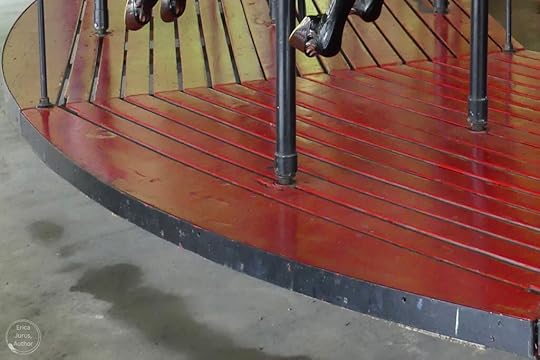 What could this photo mean? Photo by Erica Jurus, all rights reserved.
What could this photo mean? Photo by Erica Jurus, all rights reserved.A picture may be worth a thousand words, but as an author clearly I love a great collection of words. Still, I also believe in the power of photographs.
The lead photo for this blog is a mysterious teaser. I had a particular theme for tonight’s blog in mind, but after a weekend of research, I need to track down one more thing – requiring a fun little road trip in a couple of days.
Photos tell their own stories. Even family photos capture moments in time. Great photos practically leap out their medium and stay with you for a long time afterward. There’s always more to the story, though, as is the case in the article I wanted to share with you while I continue working on a special post for next week.
It’s called 10 iconic images of the most historic moments at the Olympic Games, and the photos are remarkable. But the little blurbs that accompany each photo provide so much fascinating detail about the history behind them. Personal stories are always what resonate with readers, and these are no exception.
Take No. 4, for example. When two U.S. athletes, Tommy Smith and John Carlos won gold and bronze medals (respectively) at the 1968 event in Mexico City, they felt strongly that they needed to raise their fists in a ‘Black Power Salute’ when they stepped onto the podium, to protest racial injustice. That decision ended up costing them dearly, and the photo is a testament to the power and drama of the moment.
I hope you enjoy the stories these photos convey, and next week hopefully I’ll have gathered some great photo-stories of my own for you to read and be entertained by. My photo above is a clue – can you figure it out?
The post The power of photos first appeared on Erica Jurus.
July 9, 2024
Anti-Boredom Month: I have the solution!

Is July a boring month? I guess it depends on your perspective. I don’t love the summer, as a season – it’s generally oppressively hot and humid where I live. But the month of July does include a couple bits of excitement, for me anyway: 1) stores start selling Halloween merchandise (only 115 days left ); and 2) hubby and I celebrate the week of the Open Golf Championship in Britain, where the weather is almost invariably cool out on the course, by eating delicious British food and pretending it’s sweater weather.
Boredom is a kind of Jekyll-and-Hyde emotion. At its most benign, it fits this description from the Days of the Year website: “boredom is about more than just having nothing to do; it’s about the activities at hand failing to engage us mentally”.
So perhaps we need to try something new. That’s a pretty reliable antidote to boredom – try a new restaurant, visit a new garden, hike somewhere you haven’t been before, see something intriguing at the theatre, even try a new sport.
But it turns out that doing an activity that bores us can be rather liberating, actually, from a creativity standpoint. I’ve gotten some of my best ideas when I’ve been out for a walk, just getting some exercise, with my mind free to wander and go off on tangents – OR (and many writers will attest to this) when I’m falling asleep and not thinking about anything in particular.
The dark side of boredom can be harmful. When people are either prevented in doing what they want (e.g. children who must attend an adult function instead of being allowed to play), or are forced to do something they don’t want to (perhaps like writing lines over and over on a chalkboard as punishment), or don’t have access to meaningful activity, they can get into trouble.
It turns out that the feeling of boredom is so disagreeable to people that some are willing to do almost anything to relieve it. In one study, some participants were willing to give themselves small electric shocks rather than sit there with nothing but their own thoughts.
In another, a computer system that tutored students in physics, not the most scintillating of subjects in school, was programmed to be rude – it insulted people who made mistakes and sarcastically praised those who got things right. Interestingly, the learners who used it seemed engaged by the novelty of the disagreeable software and did better in the course.
The month of July received its designation as National Anti-Boredom Month in the 1980s, when a man named Alan Caruba decided to provide some stimulus for people suffering the doldrums of summer after ‘the excitement of Independence Day’, which may make it a uniquely American holiday, but we can get into the spirit of it.
Caruba’s idea was to encourage people to explore new things to add some excitement to their lives, and also to embrace allowing their brains to just run in the wild, so to speak.
There are plenty of suggestions online about how to alleviate your July boredom, from “cooking” (I guess for people who don’t usually do it?) to playing board games (I’m up for that one) to cleaning something (not my idea of fun, but whatever).
I think we can come up with something better than that, don’t you? Getting out in nature, and exploring places you’ve never been to are always worthwhile. Find something to celebrate, if it resonates with you, like my household does around the spirit of cold weather during the Open Championship – any excuse to make great food!
But my best suggestion is to read – preferably my second novel, Into the Forbidden Fire, which is being released this Friday! A continuation of Romy Ussher’s quest to survive the bizarre supernatural world she’s been dragged into, thwarting monsters and twisted adversaries, while she grows closer to her greatest ally, enigmatic professor Rad Enkara, who has some secrets of his own. Her energy levels are dangerously unbalanced after an aborted attempt by the town council of a nearby community to use her for their own ends, and Rad offers a solution: going through the Fires of Rhyxa.
It’s an option that will help her, and enhance her powers enough to save Earth and the people she loves from an ancient and world-wide conspiracy. But it’s the opposite of a win-win — she may lose her humanity in the process and become the greatest predator the galaxy has ever seen, destroying everything she’s sworn to protect. Find out what choice she makes, and then in the final book of the trilogy we’ll see the personal cost for her as well as the consequences for the entire planet.
I’m so excited to bring the second chapter of Romy’s epic journey to my readers! (And while Book 3 isn’t finished yet, I can tell you that it will be a killer!)
Hope you enjoy, and please do me the kindness of posting a review on Amazon, which counts in their algorithm for promoting books to new readers. Happy summer reading 
The post Anti-Boredom Month: I have the solution! first appeared on Erica Jurus.
July 2, 2024
Let’s eat Grandma vs Let’s eat, Grandma
 Quote source: 32 Extremely Funny English Proofreading Rules
Quote source: 32 Extremely Funny English Proofreading RulesThe final proofread/edit of a novel. It’s the thing writers dread. We start with hope, that our text will be perfect, and clean and delightful – and then we come across the dreaded typo, or a phrase that contradicts a previous one, that just glare at us off a page. Dammit!
It’s a necessary evil. It’s better that we find these evil errors and excise them before they get published. (Rule No. 12: Avoid alliteration. Always. 32 Extremely Funny English Proofreading Rules)
Books aren’t perfect when they’re written. We go back and make them better through numerous edits.
I love this quote from William Zinsser – it captures exactly what a good writer is trying to do:
“I don’t like to write; I like to have written. But I love to rewrite. I especially like to cut: to press the DELETE key and see an unnecessary word or phrase or sentence vanish into the electricity. I like to replace a humdrum word with one that has more precision or color. I like to strengthen the transition between one sentence and another. I like to rephrase a drab sentence to give it a more pleasing rhythm or a more graceful musical line. With every small refinement I feel that I’m coming nearer to where I would like to arrive, and when I finally get there I know it was the rewriting, not the writing, that won the game.” William Zinsser, On Writing Well: The Classic Guide to Writing Nonfiction
But through all those edits, errors inevitably creep in. Hence the chore of proofreading, of sifting through thousands of sentences with a fine-toothed comb. Mayhem results if we don’t.
So, after days of editing and proofreading my latest novel, book 2 of my Chaos Roads trilogy, available on July 12, 2024 (I hope – if I don’t find anything else that needs to be changed lol), I’m now busily formatting it for publication. Front cover, spine, back cover. ISBN numbers for each different version of the book (three in my case: one for the printed version, one for the ebook/Kindle version, one for the EPUB version). Dedication; acknowledgement; maps; List of Characters.
It’s all fun, but time-consuming, so I’m going to leave you in the good hands of a couple of amusing things about proofreading that I found on the internet. Hope you enjoy!
 Source: screenshot from https://www.col-print.co.uk/
Source: screenshot from https://www.col-print.co.uk/ A joke sent in about proofreading by a reader to the Vappingo website. I especially like it because there’s a monk in my novel:
“In an ancient monastery, a new monk arrived to dedicate his life to subservient solitude and to join the others as they copied ancient records. The first thing he noticed was that the other monks were copying, by hand, books that had already been copied by hand.
The new monk had to speak up: “Forgive me, Brother Mark, but copying other copies by hand allows many chances for error. How do we know we aren’t copying someone else’s mistakes? Are they ever checked against the originals? Who is proofreading them?”
Brother Mark was startled. No one had ever suggested that before. “Well, that is a good point, my son.” He replied, “I will take one of these latest books down to the vault and proofread it against its original document.” He went deep into the vault, where no one else was allowed to enter, and started the proofreading process.
The day passed and it was getting late in the evening. The monks were getting worried about Brother Mark. Finally, the new monk started making his way through the old vault and, after he searched for a while, he heard sobbing.
“Brother Mark?” he called. The sound of the sobbing grew louder as the monk drew nearer to Brother Mark. He finally found the old monk sitting at a table with both the new copy and the original ancient book in front of him. It was obvious that Brother Mark had been crying for a long time.
“What is the matter?” asked the concerned new monk. “Oh, my Lord,” sobbed Brother Mark, “the word is ‘CELEBRATE’ !” “
Shared from Proofreading Joke: An Important Distinction, https://www.vappingo.com/word-blog/proofreading-joke/
The post Let’s eat Grandma vs Let’s eat, Grandma first appeared on Erica Jurus, author.
June 25, 2024
Monday’s Facebook quote may not have made a lot of sense ...

Monday’s Facebook quote may not have made a lot of sense to you initially, but it will in two shakes  .
.
Today we’re looking at idioms, which are so pervasive in our culture that we rarely think about them.
It’s hard to find an adequate definition of “idiom”. The worst I came across was “a group of words established by usage as having a meaning not deducible from those of the individual words”. We might have to beat our brains out to make sense of that one – it’s a good thing examples were provided (“e.g., rain cats and dogs, see the light”).
The way I’d define it is a phrase we all understand to represent, and usually, emphasize, an idea – even if the phrase itself doesn’t make literal sense. We know that it never does actually rain cats and dogs, but for some reason we understand that it means raining heavily.
According to the U.S. Library of Congress, the origin of the idiom is unknown. However, some possibilities are:
Odin, the Norse god of storms, was often pictured with dogs and wolves, which were symbols of wind. Witches, who supposedly rode their brooms during storms, were often pictured with black cats, which became signs of heavy rain for sailors. Therefore, “raining cats and dogs” may refer to a storm with wind (dogs) and heavy rain (cats).“Cats and dogs” may come from the Greek expression cata doxa, which means “contrary to experience or belief.” If it is raining cats and dogs, it is raining unusually or unbelievably hard.“Cats and dogs” may be a perversion of the now obsolete word catadupe. In old English, catadupe meant a cataract or waterfall. A version of catadupe existed in many old languages. In Latin, for example, catadupa was borrowed from the classical Greek κατάδουποι, which referred to the cataracts of the Nile River. So, to say it’s raining “cats and dogs” might be to say it’s raining waterfalls.The second theory sounds pretty reasonable to me; we certainly have drawn many words from Greek into English, so why not a few phrases?
Quite a few idioms do make a certain amount of sense. Take “calling it a day”, which means to stop working on something, usually the work day itself. An alternative version is to “pack it in”, which apparently “alludes to packing one’s things before departing, and during World War I became military slang for being killed” (Dictionary.com).
On the other hand, we all say we’re feeling “under the weather” from time to time, but where did that come from? It’s believed to have a nautical origin: when sailors were feeling sick they’d go below decks out of the bad weather that was making them feel bad, to literally ‘under the weather’.
If we “spill the beans”, we’ve blabbed about something we shouldn’t have. The best guess for that idiom’s origin ties into a method of voting in ancient Greece by placing either of two differently-coloured beans into a vase; a white bean represented yes, while a dark bean meant no. If someone knocked the jar over, the secret outcome would have been revealed.
This entire post was inspired by one of Gary Larson’s The Far Side cartoons, in which he often lampooned concepts we take for granted, like this one:
 Source: http://www.cbr.com/the-far-side-funniest-comics/
Source: http://www.cbr.com/the-far-side-funniest-comics/I love the expression on the bull in the foreground, with his shifty eyes – he’s clearly up to some mischief.
A bull in a china shop, a metaphor for someone very clumsy (and perhaps liable to break things), has murky origins as well. All that’s known is that it first made an appearance in a novel by Frederick Marryat, Jacob Faithful (1834).
But watch what happens when the Mythbusters tested the idiom out, by setting up a representative ‘china shop’ in a corral, then letting first one, then more bulls loose in it.

Idiom busted! A better expression might be ‘like a china cabinet in an earthquake’. I can offer this with some authority, having watched our friends in California, as soon as an earthquake hit, rush to hold up the china cabinet in the dining room so that it wouldn’t topple over. We were freaked, they were protecting the china. Apparently we were replaceable  . My suggestion doesn’t really apply to a person, though, just a pottery-threatening event. Ah well, better luck next time.
. My suggestion doesn’t really apply to a person, though, just a pottery-threatening event. Ah well, better luck next time.
Writers often use idioms because they’re so relatable to our readers, but poking fun at these turns of phrase sometimes is good too.
The post first appeared on Erica Jurus, author.
June 18, 2024
Fascinating alien worlds

Fantasy and sci-fi writers have so much fun creating worlds for their stories to take place in. We have total power – but, with great power comes great responsibility  For me, at least, the geography, physics and inhabitants have to make a certain amount of sense, although every year scientists find strange animals or flora/fauna that exist way out in left field.
For me, at least, the geography, physics and inhabitants have to make a certain amount of sense, although every year scientists find strange animals or flora/fauna that exist way out in left field.
What is one to make of the Titan Arum, otherwise known by the enticing nickname of Corpse Flower? The flower part, of questionable attractiveness, is the largest in the world, and consists of a central spike-like spadix that’s been described as looking like a baguette (not to me, it doesn’t), surrounded by a deep red petal of sorts that smells like rotting meat. To make itself even more attractive, the tip of the spadix is about the same temperature as a human body, which is thought to mimic a carcass but also helps the ‘scent’ disperse in the air. It’s not a carnivorous plant – instead it attracts flesh flies and carrion-eating beetles to crawl around what they think is a decomposing carcass and in the process pollinate the plant.
 New York Botanical Garden corpse flower in bloom June 27, 2018; By Sailing moose – Own work, CC BY-SA 4.0, https://commons.wikimedia.org/w/index.php?curid=70296828
New York Botanical Garden corpse flower in bloom June 27, 2018; By Sailing moose – Own work, CC BY-SA 4.0, https://commons.wikimedia.org/w/index.php?curid=70296828I mean, seriously, how did such a bizarre plant evolve? On the flip side, there’s a preying mantis that looks so much like a gorgeous orchid that insects flock to it, only to be unceremoniously eaten alive.
 An adult female orchid mantis mimicking a Phalaenopsis orchid; By Philipp Psurek – Own work, CC BY-SA 3.0 de, https://commons.wikimedia.org/w/index.php?curid=6385085
An adult female orchid mantis mimicking a Phalaenopsis orchid; By Philipp Psurek – Own work, CC BY-SA 3.0 de, https://commons.wikimedia.org/w/index.php?curid=6385085So if our planet can host such a weird assortment of inhabitants, it’s not much of a stretch to imagine all kinds of creatures on other planets.
There’s a tendency among fantasy writers to create worlds that resemble ours very closely, but that goes with the genre and is what readers expect. Science fiction can make greater leaps of the imagination.
It certainly helps when astronomers discover new heavenly bodies, and it’s amazing what they can figure out about such stars and planets even from enormous distances. Just last month the discovery of a new planet orbiting an “ultra-cool red dwarf” star was announced, stirring up all kinds of excitement, both for the nature of the dwarf star, which is only half as hot as our sun and much dimmer (100 times less luminous), and the weird life of the planet itself.
Although they sound like something rare, ultra-cool red dwarf stars – M dwarfs – actually comprise over 70% of the stars in the Milky Way. Their lower temperature, caused by slower hydrogen fusion in their cores, means that they can survive far longer than brighter stars/suns. While our own sun will burn for about 10 billion years before it turns into a gigantic red devourer of nearby planets, M dwarfs will continue on for perhaps 90 billion years longer than that. That would mean they present a longer window for life to develop on their planets, but also that they could be the last stars left shining in the universe. How cool is that (pun intended)?
This M dwarf is only around the size of our planet Jupiter – about 43,441 miles in diameter. By comparison, our sun is 865,000 miles in diameter.
The physics of such dwarf stars suggests that they could anchor numerous terrestrial planets – those with a solid surface – of a temperature that could potentially host forms of life. Maybe.
In the case of Speculoos-3b, the name given to the planet orbiting the newly-discovered red dwarf, life would be hard to imagine. The planet orbits the sun every 17 hours – making one of its years shorter than a single Earth day. As a result, Speculoos-3b receives almost 16 times more radiation per second than our planet does; it likely doesn’t even have an atmosphere to live in.
The planet is what’s called “tidally locked”: one side always faces the sun while the other remains in eternal darkness. If you visited it, you could literally ‘go over to the dark side’, which, inside an environmental bubble, might be the only place to survive (should you not mind burning a lot of electricity). But who knows what kind of life might already exist? There are enough creatures on earth that thrive in seemingly impossible environments that I don’t think we could discount a kind of life we have no reference for here on Earth.
And here’s a thrilling plot twist: what if a colony was established there, and then a hundred years into the future the planet began to rotate on its axis?
So if the human race is able to venture far out into the stars, as so many of us sci-fi oriented writers love to speculate about, and can find a habitable planet or two near an M dwarf star soon enough to survive the blazing inferno our own sun will one day turn into, who knows what kind of life we might find out there? (In case you were wondering, our sun is about 4.6 billion years old – almost half way through its projected planet-friendly lifespan. Perhaps we’d better get searching  )
)
The post Fascinating alien worlds first appeared on Erica Jurus, author.
June 12, 2024
Book ‘marks’?

I came across an amusing article about bookmarks, or shall we say: different ways of marking the spot you’ve been reading in a book. Isn’t that the same thing, you may ask.
The article is called Bookmarks: the definitive ranking, and although I had a lot of fun reading it, frankly I couldn’t believe what some people come up with for marking their passage. I’ll mention a few of them, with my personal viewpoint.
Apparently tearing out each page as you read through a book is actually a thing! Yikes!! Or tearing off part of a page to the spot you want to return to. I had never heard of this wanton destruction of the guts of a book, I guess until you’re left with nothing but the cover. So horrible I wanted to do the mental version of ‘la-la-la-la-la’ as I was reading the article.Laying a book face down with its pages spread to where you were >> See the quote by Anne Fadiman above. I think we’ve all done this at some point. It might not be the best for the book physically, but in a pinch it does the job – though not always. I’ve had books with springier binding jump back into their original position (more or less), or a book has fallen off the arm of a chair, e.g. and I’ve lost my place that way. So frustrating!Folding the book >> I’ve seen people do this with a paperback book while they’re reading it. I don’t know how they keep the book in that position to mark a page – do they put something heavy on top to keep it from unfolding itself, or put an elastic band around it? To me, if you’re going to all that trouble, you might as well just put in a bookmark.Tucking the dust jacket cover in between the relevant pages >> I’ve done that, although not for a long time because I rarely buy a book that comes with a dust jacket any more. I suspect such books are a bit of a dying breed, as the jacket invariably slides out of place and most people remove it as a nuisance.Dog-earing a page >> done that too, although never with a high-quality book.Using any object to hand >> Yup: pens, loose scrap of paper, my sleep mask…A book ribbon. These built-in book-markers are delightfully old-fashioned. I have collector’s editions of The Hobbit and Lord of the Rings, both of which include book ribbons. An elegant addition to a beautiful keepsake.Proper, i.e. made for that function, bookmarks have a long place in history. The earliest existing bookmark was found near Sakkara, Egypt and dates from the 6th century AD, made of ornamented leather with vellum on the back and attached via a leather strap to the cover of a codex (an early form of a book; this one is called Codex A, MS 813 and is in the Chester Beatty Library in Dublin, Ireland). However, there is some evidence that bookmarks go back five centuries before that.
Bookmarks were used throughout the medieval era and usually consisted of a small parchment strip or a cord, attached to the edge of the book.
The first detached book-markers began to appear in the 1850s. In modern times these accessories were abbreviated to ‘bookmark’. Apparently historical bookmarks are quite valuable and are collected by antiquarians, along with other printed paper accessories, like ticket stubs, postcards, greeting cards, menus, newspapers, posters, sheet music and so on. For example, Titanic memorabilia has a massive collectible market, as you might imagine.
Perhaps one day my custom-designed bookmarks for my trilogy of urban fantasy novels will become collectibles 
Some people take their bookmarks very seriously. There’s even an organization dedicated to them, the International Friends of Bookmarks. They state that “Membership is free of charge and qualifies for a subscription to our newsletters. It also enables you to write blog entries, articles and to display your artwork relating to bookmarks on our website.” If you’re interested in such matters, this would be the place to join like-minded individuals from around the world.
In the meantime, fess up about how you’ve marked your books to be able to return to the same spot. Inquiring minds want to know!
The post Book ‘marks’? first appeared on Erica Jurus, author.



